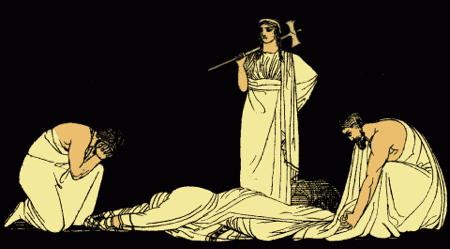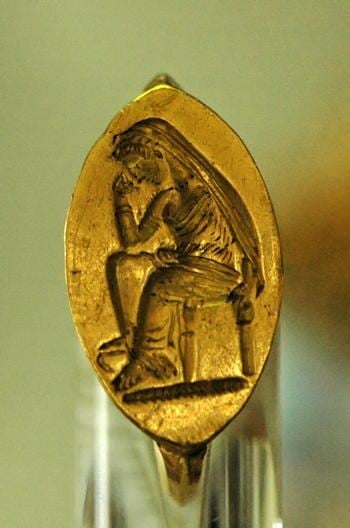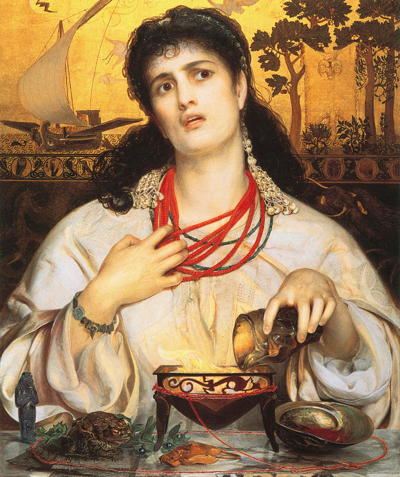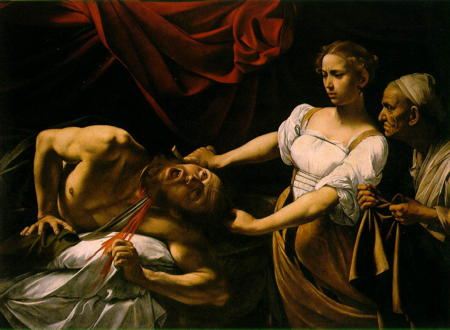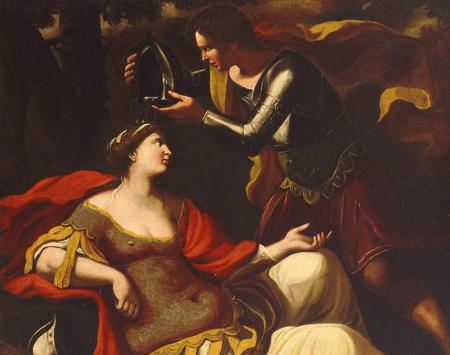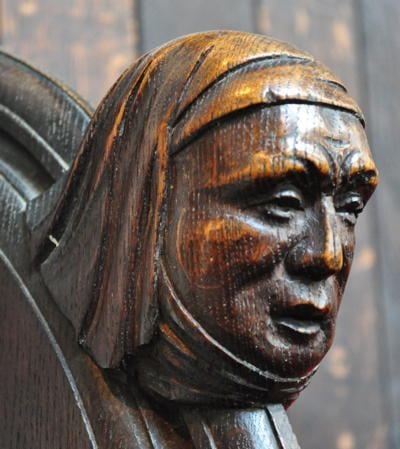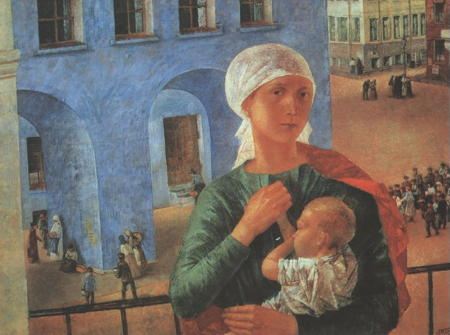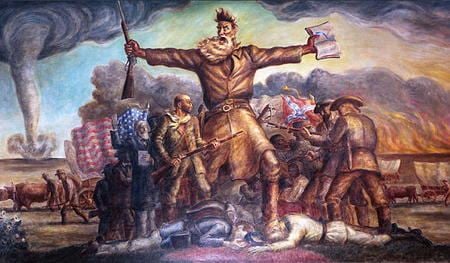“Penelope No. 1, The Stranger with the Face of a Man I Love”
Sarah Kirkland Snider
Shara Worden & Signal
Orphée Et Eurydice, “J’Ai Perdu Mon Eurydice”
Christoph Willibald Von Gluck
Maria Callas
“Song of Eurydice”
Manos Hadjidakis
Nana Mouskouri
“Conquistador”
Procol Harum
Medea “Solo un pianto con te versare”
Luigi Cherubini
Maria Callas
Metamorphosen
Richard Strauss
Given Voice
Penelope
Leandro Bassano
http://commons.wikimedia.org/wiki/File:Leandro_Bassano_-_Penelope.jpg
Charlotte Higgins in a recent review of a book on the importance of Homer generally and The Odyssey in particular (“The Mighty Dead: Why Homer Matters by Adam Nicolson”) writes about the importance of Homer in her own life. She writes, “My Homeric epiphany came seven summers ago, on a road trip to Cornwall, reading Robert Fagles’s translation aloud and having it read to me over the immense chugging of an old camper van’s engine, and then at night, by the light of an oil lamp.” She goes on to explain that her exposure to Homer had been, up to this point, a struggle with Greek Grammar and vocabulary, a struggle with translation that served to conceal the beauties of the text. But hearing it read in English where she could focus on the unraveling of the story was life changing.
The Murder of Agamemnon
Alfred Church
http://en.wikipedia.org/wiki/File:The_Murder_Of_Agamemnon_-_Project_Gutenberg_eText_14994.png
Most of us have probably only approached Homer through translations into our respective vernaculars and as a result never had to struggle with a language that is no longer spoken, even in Greece. As a result, those of us that have been transformed by Homer did not have to break through the academic walls Higgins describes, though I imagine we are also deprived of some of the richness that comes from knowing the language of the original. I recall a scene at the beginning of Terence Rattigan’s play The Browning Version where the old schoolmaster who never aroused much passion in anyone is carried away with emotion reading a passage from Aeschylus’ The Agamemnon in the original Greek. The schoolboys do not have a clue what he is saying, they have not after all mastered their Greek; like many school children, they had not done their homework the night before. But they recognize the deep emotion the Greek text has provoked in their teacher.
Gold ring representing Penelope waiting for Odysseus.
Syria, last quarter of the 5th century BC.
Anonymous
http://en.wikipedia.org/wiki/File:Ring_Penelope_CdM_Luynes_515.jpg
Marry Beard has pointed out the silence of women in this text. In a talk she gave (“The Public Voice of Women”) she discusses Penelope:
I want to start very near the beginning of the tradition of Western literature, and its first recorded example of a man telling a woman to ‘shut up’; telling her that her voice was not to be heard in public. I’m thinking of a moment immortalised at the start of the Odyssey. We tend now to think of the Odyssey as the story of Odysseus and the adventures and scrapes he had returning home after the Trojan War – while for decades Penelope loyally waited for him, fending off the suitors who were pressing for her hand. But the Odyssey is just as much the story of Telemachus, the son of Odysseus and Penelope; the story of his growing up; how over the course of the poem he matures from boy to man. The process starts in the first book with Penelope coming down from her private quarters into the great hall, to find a bard performing to throngs of her suitors; he’s singing about the difficulties the Greek heroes are having in reaching home. She isn’t amused, and in front of everyone she asks him to choose another, happier number. At which point young Telemachus intervenes: ‘Mother,’ he says, ‘go back up into your quarters, and take up your own work, the loom and the distaff … speech will be the business of men, all men, and of me most of all; for mine is the power in this household.’ And off she goes, back upstairs.
The “heroism” of Penelope is different from the heroism of Odysseus. Where Odysseus has, in addition to his wiles, swords, spears, bows and arrows, and other sharp things to help him work his will, Penelope has only her wits, her intelligence, craft, and cunning. The depiction of Penelope on the ring above captures the essence of her gifts; she is pensive and thoughtful. She holds off the suitors with her weaving (and unweaving) and it is her offer (inspired by Athena, another woman in the story) to marry whoever can win the archery contest she proposes that initiates the grand finale of the story and Odysseus’ (and Penelope’s) victory over the suitors. She makes them an offer they not only cannot refuse but cannot win. They think all they need do is shoot an arrow through some ax handles, when in reality they must first string a bow that can only be strung by Odysseus.
Medea
Frederick Sandys
http://en.wikipedia.org/wiki/File:Medea-Sandys.jpg
The songs capture the voices of three different heroines from classical myth, Penelope, Eurydice, and Medea. The title of Penelope’s song is “The Stranger with the face of a Man I Love,” which captures well Penelope’s ordeal. She recognizes the face of the returned Odysseus, but after twenty years how can he be the same man he was when he left? How can she be the same woman? But even in classical storytelling women are not always quiet and passive. There is the example of Medea and also that of Judith from the Apocryphal books of the Old Testament. These women were not easily ignored and they both exacted a brutal, and in Medea’s case not an entirely just revenge.
Judith Beheading Holofernes
Caravaggio
http://en.wikipedia.org/wiki/File:Judith_Beheading_Holofernes_by_Caravaggio.jpg
The woman warrior is, though not a common character, not an uncommon character either in Renaissance epic. One of the central characters in Ariosto’s Orlando Furioso is a woman named Bradamante. She ultimately marries another knight, Ruggerio, and their child begins the Este family. Cardinal Ippolito d’Este and Alfonso d’Este, Duke of Ferrera were both patrons of Ariosto’s. Bradamante, though, was one of the most valiant and most capable knights in the story. She marries Ruggerio because he is the only knight capable of defeating her in combat. Tasso in his poem The Liberation of Jerusalem also includes a woman warrior, Clorinda. She is a Saracen, but is baptized a Christian as she is dying. Like Bradamante she excels as a warrior. The poem is about the first Crusade and the Christian victory. Clorinda, though a Saracen, is a heroine in the story, hence her conversion (Tasso was after all a Christian poet and he is true to his loyalties). In Spenser’s Faerie Queen there is also a woman warrior that plays prominently in the story, Britomarte.
Tancred baptizes the dying Clorinda
Anonymous Italian Painter
http://commons.wikimedia.org/wiki/File:Tancredi_Clorinda_17th_century_Italian.jpg
The significance of the women warriors in these poems may only be that Tasso and Spenser were imitating Ariosto and Tasso and Spenser may only have had a woman warrior in their poems because Ariosto had one in his. The poems themselves in spite of the influence are very different from one another. Ariosto’s poem is as comic as it is heroic in its telling. Spenser poem is allegorical while Tasso’s is a straightforward heroic epic, more in the mold of The Iliad or The Aeneid. The women warriors in these poems, though, are warriors, not like Judith whose actions in the story are not in keeping with her “life’s work” or Medea who is the daughter of a king and the granddaughter of a god and as such existed between the human and the divine. Also, being the niece of Circe, a goddess of magic, her weapons were also of a different character from those of a knight in armor. Part of what makes Bradamante, Clorinda, and Britomarte interesting as characters is that they are not silenced and that they live and move through their world not as Penelope moved through hers, but as Odysseus did; that in this patriarchal society these women are treated as, or very nearly as, equals of their male counterparts. These stories also suggest that as much as we may think we understand a time and a place there are often aspects to that time and place that surprise us or do not conform to that understanding.
Margery Kempe from Kings Lynn
Carving in the church of St. Margaret in King’s Lynn
http://www.medievalhistories.com/margery-kempe/
The British Library recently digitized and made available online the first autobiography written in English, The Book of Margery Kempe (“Margery Kempe, the first English autobiographer, goes online”). Though written in English, it is the English of Geoffrey Chaucer and not the English we speak today, though with a bit of patience it can be gotten through, as Kempe’s language is closer to our own than Chaucer’s. She was a woman with a voice she was not afraid to use. Many found her an annoying person to be around and at one point in her travels those traveling with her expelled her from the group. This meant she had to travel alone through very dangerous country. She at one point confronts a bishop with the authority to execute her as a heretic. She spoke “truth to power” when such speech could be punished severely; at a time when such speech was costly. Fortunately for Kempe, the bishop backed down. She traveled the world and accomplished things few men or women of the day accomplished. It is interesting to compare Margery Kempe’s memoirs with those of John Mandeville, who claimed to travel through similar parts of the world at about the same time. Where Mandeville’s are filled with what we now know to be mythological creatures and places, filling the world he traveled with what the people of his day believed would be found there, Kempe’s story remains true to the world as it was and has been shown to be. She may have her superstitions that flavor the story from time to time, but she does not “invent”’ to make her story interesting. When looked at in light of her time her story does not need embellishment. Though her story is a spiritual one, her heroism is as real as that of any hero from myth or legend. Besides that she brewed some of the best ale in her part of the country.
Odysseus and Polyphemus
Arnold Böcklin
http://en.wikipedia.org/wiki/File:Arnold_B%C3%B6cklin_-_Odysseus_and_Polyphemus.jpg
To a certain extent the heroes of epic, myth, and folklore serve as metaphors of a kind (perhaps not metaphors in the conventional sense, but there might be a useful insight or two to be gotten by thinking of them as such, for a moment or two anyway). Their stories excite and readers come back to them in part because of the spectacle the language of the stories create in the mind. But there is more to them than just the excitement and splendor of the stories. If strength and courage were all it took to be a hero, than the sequel to The Iliad might better have been about Ajax who was a stronger and more powerful warrior than Odysseus. Even Odysseus recognizes (or so their conversation in the underworld seems to suggest) that Ajax was more deserving of Achilles’ shield. But what gets Odysseus the shield is his cunning and intellect, and Homer seems to suggest to us that these are important attributes and part of what sets Odysseus apart. Homer recognizes Odysseus’ failings and part of what he suffers on his long journey home is a kind of penance for his shortcomings, but with all his failings he remains remarkable. It is on this the heroic metaphor is built. It is the strength, tenacity, resourcefulness, adaptability and wisdom that make up the character of Odysseus that makes him metaphoric. Michael Wood in a review of Denis Donoghues new book Metaphor (“From Milton to McEwan: the beauty of metaphor”) writes:
We have recourse to our sense of absurdity in order to register the stretch and strangeness of these images. But then we need to let it go so that the images may do their enchanted work; Donoghue says, in a memorable phrase, that he thinks of reading “as enchanted interpretation”.
This is his repeated, lyrical theme. “Readers expand metaphorically when they encounter metaphor”; metaphors “add perceptions that were not there before”; a metaphor “gives us more abundant life”; metaphors “offer to change the world by changing one’s sense of it”; the source of metaphor “is the liberty of the mind among such words as there are”.
Odysseus expands our sense of the heroic. He is in many ways an unlikeable character. This is seen in his literary evolution. In Shakespeare and in Virgil (though it must be added that it served Virgil’s own epic purposes to make him less likeable) Odysseus becomes more villainous. But this un-likeability expands our sense of the hero into someone that need not be “pure” or even good in every instance. They are like us; they have a dark side, in some cases a side that is darker than our own. It is this aspect of a common, fallible humanity that makes them effective archetypes worthy of emulation. It is not the specificity necessarily of their actions so much as what they are willing to risk for a cause or a principle.
Petrograd Madonna
Kuzma Petrov-Vodkin
http://en.wikipedia.org/wiki/File:Petrograd_Madonna_(Petrov-Vodkin).jpg
Socialist Realism was an art form used by the Soviet Union and other Communist nations for propaganda purposes. The images in these paintings work because what they depict work as heroic metaphors. There is a beauty and a truth to these paintings. The women in both paintings capture a true nobility and a true heroism. What the women in these paintings represent give the propaganda the grain of truth it needs to be successful, it is a kind of “goodness by association.” The courage and purity of the images transfer to the messages and aspirations of those manipulating the images. This is something that is true of all art created with the intent to shape public opinion. It is why we need to be literate not just in language but in media; we need to know how music, images, and language affect us and shape the way we think and the conclusions we reach.
What the October Revolution gave to the female worker and peasant. 1920 Soviet propaganda poster. The Inscription of the buildings read “library”, “kindergarten”, “school for grown-ups. Etc.
Unknown Artist
http://en.wikipedia.org/wiki/File:SovietWoman1920.jpg
In America, and most of the western world, these images are seen to propagate an insidious intent and of course there is the truth of the Soviet Gulag to underscore the insidiousness of that intent. Human history is filled with those that blinded themselves to what those around them were doing because they accepted the argument that what was being done was being done to achieve a good and a noble end. But how noble and good can the ends be when the means of achieving those ends are evil? Is it possible for the ends to remain untouched by the means through which they were achieved? In reading any book or in listening to any piece of music or looking at any picture we need to consider the philosophy and the point of view that lies behind it. What work are the notes, the images, the words being given to perform? How are our thoughts and perceptions being shaped by what we see, hear, and read? In the end we all need to decide whether we are going to be passive or active consumers of the arts? A good education ought to cultivate a curiosity that seeks to understand the points of view and ways of thinking that are the foundations of the arts and entertainment we enjoy.
The Long Reach of Reason
Steven Pinker and Rebecca Newberger Goldstein
TED Talks
The animated TED Talk asks us to consider philosophy and reason and their place not just in our world but in the world of our ancestors for as far back as one would care to go. One of the participants in the discussion, Rebecca Newberger Goldstein addresses similar issues in an article she wrote for The Chronicle of Higher Education, “How Philosophy Makes Progress” (also in a new book Plato at the Googleplex). She makes an argument for what philosophy and the Humanities in general provide that science cannot. She sees philosophy occupying a space that lies between science and literature. Plato, because he distrusted the poets, excludes them from his ideal state and his philosophy, which suggests a tension exists between philosophy and literature and probably the other arts. In the article Newberger says of philosophy:
The naysayer’s view of philosophy as failed or immature science denies it the possibility of progress, as does the yea-sayer’s view of philosophy as a species of literature. But neither conforms to what philosophy is really about, which is to render our human points of view ever more coherent. It’s in terms of our increased coherence that the measure of progress has to be taken, not in terms suitable for evaluating science or literature. We lead conceptually compartmentalized lives, our points of view balkanized so that we can live happily with our internal tensions and contradictions, many of the borders fortified by unexamined presumptions. It’s the job of philosophy to undermine that happiness, and it’s been at it ever since the Athenians showed their gratitude to Socrates for services rendered by offering him a cupful of hemlock.
Philosophy is included among the Humanities, as are music, art, and literature. But it is different from the other Humanities. This shouldn’t come as a great surprise, as Biology is different from Physics even though they are all included among the sciences. What the Humanities share is a grounding in their past, their present is built upon their past (the sciences tend to kill off their past in creating their present). Also, the materials the Humanities work with are materials that cannot be tested or evaluated by the scientific method; they cannot be studied in a laboratory.
Tragic Prelude
John Steuart Curry
http://en.wikipedia.org/wiki/File:John_Brown_Painting.JPG
The Humanities give us images that are both disturbing, as the painting above and serene, as the painting below and much that is in between. All the Humanities do this, philosophy, art, music, and literature. In this respect they confront us with the difficulties and pleasures of being human. They make us confront issues we might rather avoid. They make us aware of what is beautiful and hopefully make us aware of the need to preserve what is beautiful. As is pointed out in the video and the article humanity’s moral progress is the result of reasoning through what the Humanities teach us. The world of Homer was more brutal and far less humane then our own. Yet the world of Homer gave us Homer. Much of our moral and philosophical progress began by grappling with the questions that were first, if not raised, recorded by Plato. It is in going back to reconsider these questions that we make moral progress. We often answer these questions differently than Plato and his contemporaries, but because the questions are the right questions it is important to re-ask them and to consider them in light of what has been learned about the world and our own humanity in the intervening years.
In the Blue Expanse
Arkady Rylov
http://en.wikipedia.org/wiki/File:Rylov_Blue_Expanse.jpg
What does it mean to be given voice, to be allowed to speak for ourselves, for our aspirations, for our ideals? The Humanities give us a voice that the sciences cannot. We are allowed to reason through things that do not have a concrete reality. We are free to feel things that cannot be shown to be true or relevant by any kind of scientific test. These thoughts and emotions are an important part of what it means to be human. But because we are free to think and feel these things, does that mean that these things have a place in the academy, that they are worthy of study. Edward Mendelson points out a side of the poet W. H. Auden’s character that he often kept secret ((“The Secret Auden”). Knowing his sensitivity to the sufferings of others does not increase our understanding of his poetry or provide a rationale for studying it, but perhaps in part it is because he was the kind of poet he was that he was the kind of man he was and that there is in his poems a voice that asks us to consider being kind and generous and virtuous in spite of our inclinations be otherwise, or at least to consider the possibility.
Evening on Dnieper River
Vladimir Ivanovich Ovchinnikov
Penelope had only her intellect as a weapon to confront her enemies. She had no one to fight for her and she was not permitted to fight, in the conventional sense, for herself. But she exercised a kind of voice, a subversive and a cunning voice. In this way she and Odysseus made a “perfect couple.” And perhaps the metaphor here for us, the Penelopean voice we need to find, is that in living our daily lives we need to practice that kind of heroism practiced by Penelope. We may not be in positions where we can confront those that threaten us and our ideals; we are not permitted to use weapons with sharp edges or explosives, we have to find more subtle, though equally effective way of achieving our ends. Being allowed to speak what we think is not the same thing as being given voice. To be given voice we need not only to express our views, but also to have a way of putting those views into practice. We are not silenced when our voice is silenced we are silenced when our ability to act in concert with our beliefs is prevented. It is not enough to be heard; often speaking our mind is easy. We are given voice, and often this is something that is not given to us by others but by ourselves, when we live out what we say. That’s why Aristotle thought plot was so important, it enables us to see what people do while we listen to what they say and measure the distance between the two.
Moonlight Night on the Volga River
Vladimir Ivanovich Ovchinnikov

